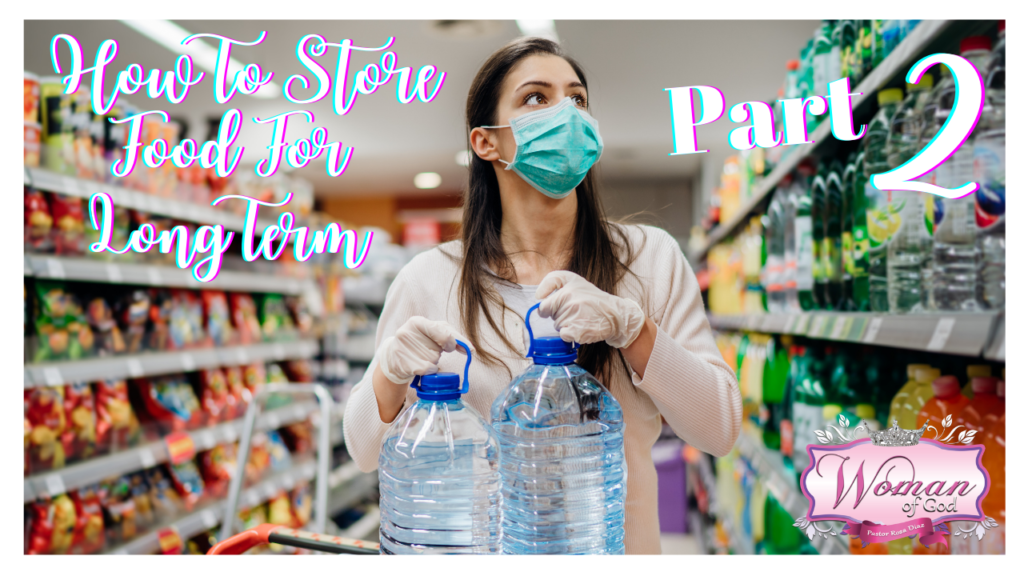We want to answer some questions that have been asked about the video (blog) on how to store food in the long term:
- One of the questions has been why do you keep food in the refrigerator; How will you preserve things in the refrigerator if the power goes out? How will you cook? The purpose of refrigerator storage is to prepare not only for a natural disaster event but also for a shortage event where there may be electricity but no food is available. Canned food is for those times when there is no electricity, if there is no electricity the food in the refrigerator is the first food we must cook obviously. But we thank God that by his grace and mercy we have options for those moments; gas stove, electric generator and solar panels.
- How to save water for the long term? One gallon of water is needed per person per day. To store the water for a long time, we must keep it in glass or plastic containers that we can seal so that it does not become contaminated. And the general rule of thumb for treating water is 8 drops of Clorox per gallon of water or 1/2 tablespoon of Clorox for every 5 gallons of water. If you don’t have a lot of space and want to save water you can use the bathtub in this 100 gallon plastic tub water container: https://amzn.to/2QSklrS
- Where do I get canned pork and beef? Ground Pork in juice or Beef. In various supermarkets like Publix, Aldis, Walmart occasionally have them. I have also seen them on e-bay although a bit expensive. Here are the Amazon links: Pork – Box of 4 28oz Cans: https://amzn.to/2QRDtGy Beef – 1 28oz Can: https://amzn.to/31XfEnb
- How to store pasta and flours? It must be in a plastic container (that does not enter the air) if we add some bay leaves it helps us for the food not to get weevil.
- Where or how can I store my food if I don’t have space? The most recommended is to choose a corner in the house and put the containers one on top of the other. The water boxes can also be put one on top of the other. These are some of the ways our subscribers are saving their food and water (photos in the video).
- Where do I get the Mylar bags; if I don’t get them I can save without them; how long will the meal last? Mylar bags are opaque, made from metalised polyester. With Mylar bags, the air is removed by the addition of oxygen absorbers, also known as oxygen scavengers. Using Mylar bags with oxygen absorbers removes up to 99.99% of oxygen. I bought them on Amazon, here are the links for the different sizes: Mylar Bags (medium): https://amzn.to/2zv6NNR Mylar Bags (5 Gallon): https://amzn.to/3go2fd1 Mylar Bags (small): https://amzn.to/3cXu3mh But in the event you can’t get a hold of these; use a 5 gallon bucket or plastic container and store your food there sealing it tight.
- How can I save food if I don’t have money and I only have enough to get through the week? We can all save. From the little we have, we have to keep something trusting that the little or much that we have God will multiply it for us. As at the time when Christ fed more than 5,000 people with only 5 loaves and two fish; or when he told the widow there will be no shortage of flour or oil in your house. We must believe God that if we move in obedience He will. When the famine was approaching to Egypt God gave instructions to Joseph to save beforehand. In the United States there are several churches and non-profit organizations that distribute food for free; They are called Food Pantry. This is an easy way to help you save extra food. The Facebook page (Castigos de Dios Para PR – Punishments of God for PR) shared a list for those who have few resources or are just beginning to prepare; this is a guide to start your provision little by little here we have provided a copy:
Food Storage Supply Plan For Low Income Families – Investing $ 5 Weekly
- Week 1: 5 # rice
- Week 2: 5 # pinto beans
- Week 3: 10 cans of vienna sausages
- Week 4: 10 cans of tomato sauce
- Week 5: 5 # sugar
- Week 6: 5 # all-purpose wheat flour
- Week 7: 1 gallon of vegetable oil
- Week 8: 5 # rice
- Week 9: 5 # white beans
- Week 10: 5 cans of fruit
- Week 11: 1 small can of powdered milk
- Week 12: 5 # salt
- Week 13: 5 cans of tuna
- Week 14: 6 # pasta
- Week 15: 10 cans and vegetables
- Week 16: 5 # rice
- Week 17: 5 # red beans
- Week 18: 2 cans of ham
- Week 19: 2 pots of peanut butter
- Week 20: 5 cans of chicken
- Week 21: 3 # shortening
- Week 22: 5 # sugar
- Week 23: 10 cans of vegetables
- Week 24: 5 # rice
- Week 25: 5 # pink beans
- Week 26: 10 cans of tomato sauce
- Week 27: 6 # pasta
- Week 28: 5 spice pots
- Week 29: 5 cans of fruit
- Week 30: 1 gallon of vegetable oil
- Week 31: 1 small can of powdered milk
- Week 32: 5 # rice
- Week 33: 5 cans of turkey
- Week 34: 2 # yeast
- Week 35: 5 # cornmeal
- Week 36: 1 pot of honey
- Week 37: 10 cans of vegetables
- Week 38: 5 boxes of Mac & Cheese
- Week 39: 6 # pasta
- Week 40: 3 # dehydrated potatoes
- Week 41: 5 # chickpeas
- Week 42: 2 cans of corned beef
- Week 43: 5 cans of fruit
- Week 44: 5 # sugar
- Week 45: 5 cans of pork
- Week 46: 10 cans of tomato sauce
- Week 47: 2 gallons of white vinegar
- Week 48: 3 # dehydrated potatoes
- Week 49: 5 # lentils
- Week 50: 5 cans of chicken
- Week 51: 5 # rice
- Week 52: 3 # dehydrated potatoes

